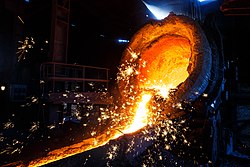
Back Grys yster Afrikaans حديد زهر رمادي Arabic Šedá litina Czech Gråt støbejern Danish Fundición gris Spanish چدن خاکستری Persian Fonte (métallurgie)#Fonte grise French Sivi lijev Croatian Ghisa lamellare Italian ねずみ鋳鉄 Japanese
| Steels |
|---|
 |
| Phases |
| Microstructures |
| Classes |
| Other iron-based materials |

Gray iron, or grey cast iron, is a type of cast iron that has a graphitic microstructure. It is named after the gray color of the fracture it forms, which is due to the presence of graphite.[1] It is the most common cast iron and the most widely used cast material based on weight.[2]
It is used for housings where the stiffness of the component is more important than its tensile strength, such as internal combustion engine cylinder blocks, pump housings, valve bodies, electrical boxes, and decorative castings. Grey cast iron's high thermal conductivity and specific heat capacity are often exploited to make cast iron cookware and disc brake rotors.[3]
Its former widespread use[when?] on brakes in freight trains has been greatly reduced in the European Union over concerns regarding noise pollution.[4][5][6][7] Deutsche Bahn for example had replaced grey iron brakes on 53,000 of its freight cars (85% of their fleet) with newer, quieter models by 2019—in part to comply with a law that came into force in December 2020.[8][9][10]
- ^ Smith & Hashemi 2006, p. 431.
- ^ Schweitzer 2003, p. 72.
- ^ "Introduction to Gray Cast Iron Brake Rotor Metallurgy" (PDF). SAE. Retrieved 2011-05-24.
- ^ "Noise abatement measures on the current rolling stock". Commission of the European Communities (pdf) (in German). 8 July 2008.
- ^ Thomas, Peter. "Gegen Lärm von Güterzügen:Mit Flüsterbremse und Schallschutzwand". Faz.net.
- ^ Thomas, Peter. "Bahnverkehr: Gegen den Lärm der Güterzüge - Technik & Motor - FAZ". Faz.net.
- ^ "Schienenverkehr ist deutlich leiser geworden | Allianz pro Schiene". 12 November 2021.
- ^ "DB Progress on Reducing Rail Freight Noise Pollution | Railway-News". 23 April 2019.
- ^ "For low-noise freight trains: Mobile service teams replace brake blocks at any location". www.db-fzi.com.
- ^ "Railway Noise Mitigation Act | Deutsche Bahn AG".
© MMXXIII Rich X Search. We shall prevail. All rights reserved. Rich X Search